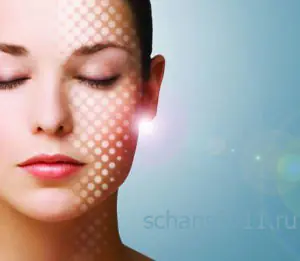
In modern conditions, facial skin rejuvenation is one of the problems that can be solved without resorting to the services of a plastic surgeon.
Currently, beauty salons offer a wide range of services.
Among a large number of modern technologies, you can choose one or another technique, based not only on indications and contraindications, but also on financial capabilities.
One of the most popular methods is fractional laser rejuvenation.
The advantages of the technique are its safety and high efficiency.
The final result and rehabilitation period are largely determined by the type of installation.
What is laser rejuvenation
For rejuvenating procedures, carbon dioxide and erbium lasers are used, the distinctive features of which are different wavelengths and degrees of energy absorption.
These characteristics determine the technology of influence.
- A carbon dioxide (CO2) device is used for ablative skin rejuvenation. In this case, the laser beam affects both the superficial and deep layers of the skin. Ablative rejuvenation allows you to smooth out all skin irregularities, whiten age spots and get a quick effect from laser exposure. The rehabilitation period with this method of exposure ranges from one to two weeks.
- Non-ablative laser rejuvenation characterized by deep beam penetration and no damage to surface layers. With this method of exposure, the rejuvenating effect appears gradually, but due to the lack of damaging effects on the upper layers of the skin, the rehabilitation period is shortened.
The method of non-ablative skin rejuvenation is suitable for those who do not want to disrupt the usual rhythm of life and whose goal is only to improve the turgor and elasticity of the skin.
Why is laser therapy an effective procedure?
Modern laser systems: CO2 and erbium, have a fractional effect, due to which only 20% of the skin volume is damaged.
The restoration process is launched over its entire surface, which minimizes the process of thermal damage to the skin and the appearance of scars, and also activates the regeneration process and the synthesis of new cells. As a result, the skin is tightened and rejuvenated.
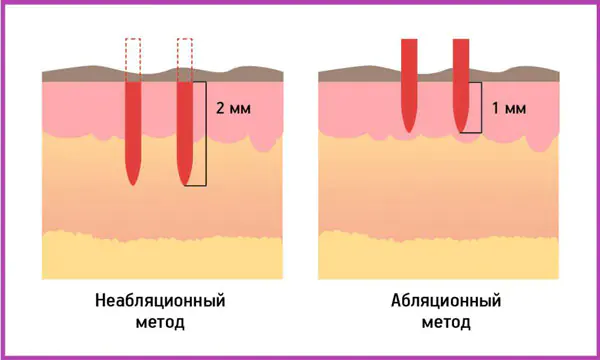
Indications for the ablative method
As mentioned above, ablative rejuvenation is a fairly effective way to smooth out shallow wrinkles, increase the firmness and elasticity of the skin, and combat age spots. Since the laser works mainly in the upper layers of the skin, it is renewed throughout the entire depth of penetration of the beam and visible correction of all flaws.
The result is noticeable after just one procedure.
Who is recommended for non-ablative rejuvenation?
Laser non-ablative skin rejuvenation is used for:
- smoothing wrinkles;
- removal of pigmented areas of the skin;
- lifting effect;
- increasing skin firmness and elasticity;
- skin rejuvenation;
- elimination of skin defects.
This method of fractional laser rejuvenation is ideal for you if you want to achieve a noticeable result without intensive exposure with a minimum rehabilitation period.
When to refuse the procedure
Like most methods, laser therapy has a number of contraindications.
Among them, it is worth paying attention to the following problems:
- blood coagulation disorder;
- pregnancy status;
- epilepsy disease;
- presence of cancer;
- acute infectious diseases;
- increased body temperature;
- the presence of an inflammatory process in the area affected by the laser beam.
Important!
After laser rejuvenation, the skin becomes very sensitive, so you should not expose it to sunlight for some time.
Photo: before and after



Reviews
Reviews about the laser treatment procedure are the most controversial.
- Those who have used this service to smooth out wrinkles are satisfied with the results, but are advised to use a more gentle rejuvenation method.
- In cases of post-acne treatment, the reviews are also positive and the results of the disappearance of scars and acne scars, as they say: on the face.
But most note that the procedure is quite painful and the rehabilitation period leaves much to be desired.
In addition, laser therapy is a rather expensive procedure.
3 comments
A friend of mine used laser skin rejuvenation. True, the rehabilitation period took a very long time, but she was satisfied with the result. The skin noticeably tightened and acquired freshness.
Non-ablative laser rejuvenation today is an excellent alternative to plastic surgery. Age-related changes in the skin make themselves felt and you want your face to look youthful longer. The most important thing is to get into the hands of a professional.
And I experienced the effects of a laser myself. What I want to say: the procedure is painless, as it was carried out under anesthesia. But the rehabilitation period was difficult. I had to take time off from work because my face looked really bad. But when everything returned to normal, I was pleased with the result.
Laser cosmetology is developing rapidly, and its popularity is growing every day. Now we can say with confidence that it has become a worthy alternative to classical surgical techniques. At the same time, the risks for patients are minimal. Some technologies, such as non-ablative laser rejuvenation, reduce the rehabilitation period to just a few days. This is especially convenient for those who cannot afford to be away from a busy work schedule for a long time, but still want to look good.
The essence of the procedure
The laser beam is universal. It can easily cut through sheet metal several millimeters thick or machine soft surfaces with micron precision. Initially, it was used in cosmetology as a replacement for a surgical scalpel. A little later, a laser resurfacing procedure appeared, in which the top layer of skin was literally burned out by a photon beam. Rehabilitation after such treatment lasted up to several weeks and caused a lot of inconvenience.
The phenomenon when skin cells instantly disappear from its surface is called ablation. Its essence is the rapid evaporation of the liquid in the tissues, during which the cell membranes rupture. Their remains are then absorbed by phagocytes and excreted from the body naturally. And young healthy cells replace the destroyed layer.
With more delicate laser non-ablative rejuvenation, tissues are heated to a temperature not exceeding 60 o C. Already after 40 degrees, the process of denaturation of the protein that makes up collagen fibers begins.
This achieves the effect of instant skin tightening. At maximum temperatures, the coagulation process starts, after which a thin crust forms on the damaged areas of the skin, and small vessels and capillaries are sealed.
Recently, fractional lasers have been increasingly used for the procedure. This is a device with a special attachment that splits the photon beam into tiny streams - fractions. This allows you to cause even less damage to the top layer of skin with virtually no reduction in the effectiveness of the procedure. The recovery period is significantly reduced and often does not exceed several days.
Method action
The laser beam penetrates into the depth of the skin from a few microns to 3-4 mm. In this case, its surface layer is not completely destroyed, although the natural protection is significantly weakened. As a result of this impact you get:
- reducing the depth of facial wrinkles;
- almost complete elimination of small ones;
- noticeable skin tightening;
- restoration of clarity of the oval of the face;
- reduction of jowls and double chin;
- elimination of shallow pigmentation;
- smoothing skin texture;
- elimination of spider veins and mesh;
- narrowing of enlarged pores;
- increasing skin tone;
- improvement and evenness of complexion.
Visually, after non-ablative rejuvenation, patients begin to look fresher. And after a properly carried out course of treatment, you can “erase” from 5 to 10 years from your face. At the same time, there are no wrinkles, scars or other marks left from surgical operations.
Advantages
The main advantage of non-ablative fractional laser rejuvenation is its extremely delicate and precise effect. When treating a problem area, neighboring tissues are not damaged, which allows you to work calmly with the correct equipment settings even in the periorbital area, effectively eliminating crow's feet and expression lines around the eyes.
Also, the advantages of non-ablative technology are:
- absence of severe peeling and inflammation of the skin;
- relatively short period of active rehabilitation;
- the ability to work on dark and tanned skin;
- safety of using the technique in the summer season;
- minimal discomfort during the procedure;
- pronounced cumulative effect;
- The permissible age of patients is up to 65 years.
It is noteworthy that this is one of the few anti-aging procedures that can be done on very sensitive skin. On it, redness and swelling will be more pronounced and will last longer, but no serious negative reactions will occur.
Complications and disadvantages
The non-ablative technique virtually eliminates the occurrence of side effects and complications. They are only possible if the cosmetologist is illiterate or uses low-quality equipment. The head of the device has a limited service life and, if it is not replaced in time, during the procedure you can get severe burns to soft tissues.
The main disadvantages of non-ablative rejuvenation are its high cost and relatively low efficiency compared to other laser technologies. Experts consider the indication for its use to be the manifestation of the first signs of aging, and the optimal age range is from 30 to 45-50 years.
While a non-ablative laser copes well with shallow pigmentation, post-acne spots and uneven skin surfaces, it is no longer capable of dealing with more serious problems.
Even after several procedures, it will not be possible to completely remove old scars, multiple stretch marks and very deep skin folds. Therefore, it is often combined with ablative techniques.
Preparation and Execution
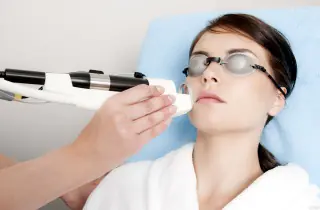
It is extremely important to find a highly qualified specialist to perform the procedure using non-ablative technology. Due to the delicate effect on the skin, there is simply no universal technique that would suit everyone. And we have to select an individual program for each patient, taking into account the age and condition of the skin.
The preparatory stage can be very short. With the non-ablative method, you do not have to wait for the tan to fade. It also allows you to work on skin with small non-purulent pimples or acne (its condition noticeably improves after the procedure). The most important thing is to make sure there are no contraindications.
A few days before the first session, it is very important to prevent damage or severe irritation of the skin in problem areas. Therefore, it is better to refuse alcohol-containing cosmetics and not do peelings.
It is also necessary to stop taking anticoagulants, tetracycline antibiotics and retinol. On the day of the session, it is better not to apply any creams to your face at all.
The procedure is quite comfortable and takes from 10 minutes to half an hour. The patient does not experience severe pain, so the use of even local anesthesia is usually not required. But for people with a high sensitivity threshold it is allowed.
The procedure flow looks like this:
- the patient is comfortably placed on the couch;
- hair must be tucked under a disposable cap;
- the face is thoroughly cleaned of any remaining cosmetics;
- A cooling conductive gel is applied to problem areas;
- the head of the device is slowly moved over the skin;
- when you press the button, a laser beam is generated;
- After treating the entire surface, apply a mask with panthenol.
Within 15-20 minutes after the end of the session, you can safely go home.
The big advantage of the non-ablative technique is that the face is not covered with a continuous crust. It can only form in small areas where there were many damaged cells. There is no severe pain. Swelling and redness begin to subside on the second day and completely disappear by 3-4.
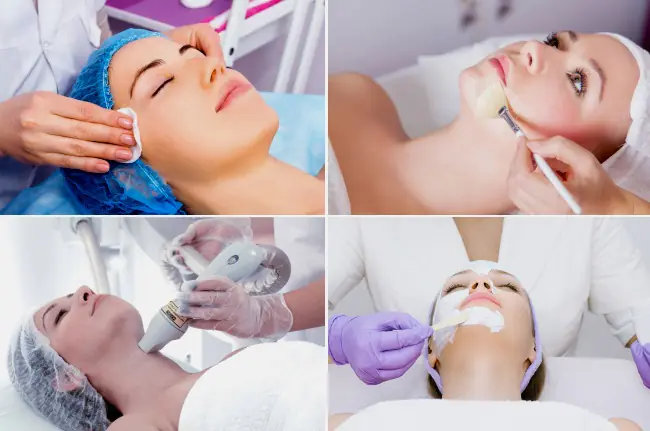
To speed up the skin healing process, it is advisable to follow these recommendations:
- give up smoking and alcoholic beverages for at least a few days;
- do not touch your face with your hands again and do not massage it;
- do not engage in active sports, do not visit the sauna and swimming pool;
- sunbathing and solarium are also prohibited for now;
- Do not make homemade masks or any salon procedures;
- You cannot use decorative cosmetics;
- no peelings, scrubs or other mechanical irritations of the skin.
In the first 2-3 days, you should not take hot baths or wash your face with very warm water. It is better to wash in the shower so that water and shampoo do not get too much on your face.
You can go to work that does not involve harmful working conditions and heavy physical exertion within 3-4 days. But before going outside, be sure to apply sunscreen.
Contraindications
There are fewer contraindications to non-ablative rejuvenation than to more aggressive techniques. But still the list is quite impressive:
- pregnancy and lactation;
- inflammation of problem areas of the skin;
- tendency to severe allergies;
- infectious skin diseases;
- diabetes mellitus and hypertension;
- cardiovascular failure;
- epilepsy and serious mental disorders;
- any neoplasms in the work area;
- oncology and autoimmune diseases.
The procedure cannot be performed if there is an exacerbation of diseases of the internal organs or if the body temperature is elevated for any reason. But these are relative contraindications - as soon as the symptoms disappear, you can go to the session.
Reviews and results
According to reviews from most patients, non-ablative laser rejuvenation is indeed very easy to tolerate and gives excellent results. After 3-6 sessions, which are carried out once every 2-4 weeks, you can look 5-10 years younger, without taking long breaks from work and without suffering serious inconveniences during the recovery period.
The technology allows you to preserve the upper layer of the epidermis as much as possible. Partially the protective properties of the skin are preserved and you can safely go outside for 2-3 days, not forgetting about protection from ultraviolet radiation. It successfully copes with most of the first signs of aging. But in order to permanently remove facial wrinkles in the frontal area and nasolabial folds, it is advisable to introduce Botox after completing the rejuvenation course, which will not allow the muscles to contract and create new skin creases. The lifting effect with proper facial care lasts up to 3-5 years.
Designed to eliminate age-related skin changes caused by endogenous and exogenous factors. Non-ablative laser rejuvenation is also called “thermolifting”. Its effect is similar to that of radio wave lifting, but the procedures have a number of fundamental differences.
The essence of non-ablative laser rejuvenation
Non-ablative laser rejuvenation is based on the conversion of light energy into heat. Thermal exposure has a beneficial effect on metabolic and biochemical reactions in the cellular and extracellular matrix of the skin. In particular, the process of formation of new collagen fibers, called neocollagenesis, is launched.
With non-ablative laser rejuvenation, tissues are heated to 45-85°C, which is not enough for full ablation (temperature evaporation of liquid), but the process is sufficient to start the process of denaturation and coagulation of the most important proteins in our skin - elastin and collagen. The radiation is absorbed by skin chromophores, and then, bypassing the epidermis, partially penetrates into the dermis, also providing an antibacterial effect.
The main goal of non-ablative laser rejuvenation is to prevent the progression of age-related changes and improve the quality characteristics of the skin. The procedure is recommended for patients aged 25-40 to maintain youthful skin. In some cases, it is prescribed for medical reasons (for example, in the treatment of chronic acne).
For non-ablative laser rejuvenation, various types of lasers are used: neodymium, diode, erbium (erbium glass). The wavelength ranges from 532-1540 nm.
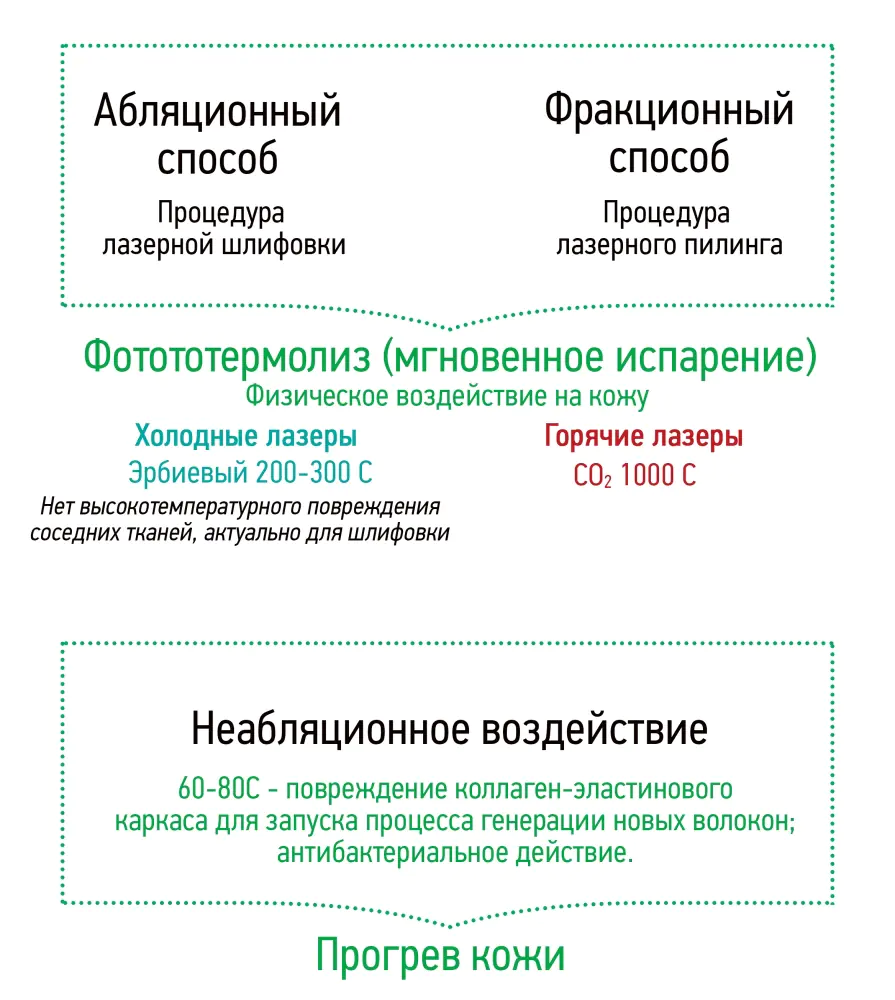
Indications for non-ablative laser rejuvenation
Indications for non-ablative laser rejuvenation include the following problems:
- Porosity and pastiness of the skin;
- “Tired” and haggard appearance of the face;
- Weak manifestations of hyperpigmentation and hyperkeratosis;
- First mimic, mesh or linear wrinkles;
- Loss of turgor and skin tone on the face, neck, and décolleté;
- Dilated subcutaneous vessels;
- Dull complexion;
- Skin dehydration;
- Acne and post-acne.
Types of non-ablative laser rejuvenation
Non-ablative laser rejuvenation can be carried out using a continuous or fractional method. In the first case, the effect is carried out on the entire surface of the skin, and in the second, the laser affects certain points (fractions). The specific type of procedure is selected by the cosmetologist based on the indications and initial data.
Non-ablative laser rejuvenation is atraumatic in any case. The surface layer of the skin is not subject to destruction or destruction, so there is no rehabilitation period. The rejuvenating effect of the procedure appears gradually and has a tendency to accumulate. The goal of non-ablative laser rejuvenation is gradual dermal remodeling.
A relative disadvantage of non-ablative laser rejuvenation is the need to undergo a full cycle of procedures. Typically, to achieve good results, 3 to 10 sessions are required with a time interval of 10-30 days. When treating acne/post-acne, this course of therapy allows you to achieve the best results.
Rehabilitation is simple, so the patient does not feel the typical discomfort and need for long-term recovery.
Recovery period
The complications or consequences of the procedure typical for laser peelings and resurfacing are practically not felt with non-ablative laser rejuvenation. In the first 1-2 days, slight redness and increased skin temperature are possible. Then these signs disappear, without even leaving behind peeling.
Rehabilitation after non-ablative laser rejuvenation does not require restrictions or therapeutic manipulations from the patient, however, the cosmetologist should give you recommendations to consolidate the effect obtained.
Non-ablative laser rejuvenation can be safely classified as a “lunch break” procedure - immediately after its completion, the patient can return to normal activities and interact with people without being embarrassed about their appearance.
It should be understood that non-ablative laser rejuvenation is essentially a therapeutic, too soft and “gentle” procedure, so it is naive to expect an effect comparable to that of a surgical lift. The procedure is suitable for maintaining facial skin in a healthy and youthful state, but does not provide global anti-age results. For patients with obvious sagging and ptosis of the skin, dark and heavy pigmentation, loose wrinkles and folds, classic laser resurfacing or “fractional resurfacing” - procedures with an ablative effect - are more suitable.
The result of non-ablative laser rejuvenation
The result of non-ablative laser rejuvenation will be a number of positive changes:
- Narrowing and reduction of pores;
- Uniformity of skin microrelief;
- Fresh, uniform, beautiful skin tone;
- Increased elasticity and contractility of the skin;
- Smoothing shallow skin creases;
- Softness, velvety, matte skin.
Non-ablative laser rejuvenation is suitable for those who want to protect themselves from early aging and for those who are contraindicated for more aggressive laser procedures.
The key condition for achieving visible effects of non-ablative laser rejuvenation is following the quantitative and interval scheme of procedures selected by the cosmetologist.



